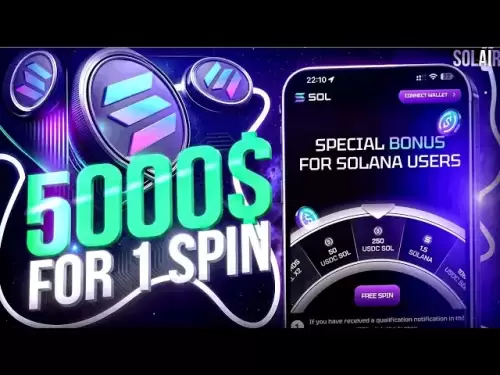-
 Bitcoin
Bitcoin $119,161.9671
1.52% -
 Ethereum
Ethereum $2,995.0722
2.34% -
 XRP
XRP $2.8555
5.32% -
 Tether USDt
Tether USDt $1.0002
0.00% -
 BNB
BNB $692.9308
1.48% -
 Solana
Solana $162.9611
1.87% -
 USDC
USDC $0.9999
0.00% -
 Dogecoin
Dogecoin $0.2014
2.84% -
 TRON
TRON $0.3032
0.90% -
 Cardano
Cardano $0.7464
6.51% -
 Hyperliquid
Hyperliquid $49.1533
5.71% -
 Stellar
Stellar $0.4773
24.77% -
 Sui
Sui $3.4979
3.93% -
 Chainlink
Chainlink $15.8552
6.01% -
 Hedera
Hedera $0.2401
23.85% -
 Bitcoin Cash
Bitcoin Cash $510.0474
0.97% -
 Avalanche
Avalanche $21.5550
4.82% -
 UNUS SED LEO
UNUS SED LEO $9.0389
-0.47% -
 Shiba Inu
Shiba Inu $0.0...01340
2.27% -
 Toncoin
Toncoin $2.9910
0.62% -
 Litecoin
Litecoin $96.4406
4.34% -
 Polkadot
Polkadot $4.0359
4.59% -
 Monero
Monero $338.4759
2.80% -
 Uniswap
Uniswap $8.6460
4.01% -
 Dai
Dai $0.9999
0.00% -
 Ethena USDe
Ethena USDe $1.0007
0.03% -
 Pepe
Pepe $0.0...01254
3.26% -
 Bitget Token
Bitget Token $4.3969
0.79% -
 Aave
Aave $312.2641
3.98% -
 Bittensor
Bittensor $397.0731
4.17%
What do I need to start mining crypto?
Crypto mining involves verifying transactions and earning rewards through powerful hardware like GPUs or ASICs, with profitability depending on energy costs and setup efficiency.
Jul 13, 2025 at 12:28 am

Understanding the Basics of Crypto Mining
Crypto mining is the process by which transactions are verified and added to a blockchain, and new coins are introduced into circulation. Miners use powerful computers to solve complex mathematical problems, and in return, they are rewarded with cryptocurrency. Before diving into the technical aspects, it's important to understand what proof-of-work (PoW) means and how different cryptocurrencies like Bitcoin (BTC), Ethereum (ETH), or Litecoin (LTC) have varying mining algorithms.
Mining requires both hardware and software resources, as well as a good understanding of how consensus mechanisms work in decentralized networks.
Selecting the Right Hardware for Mining
The foundation of any successful mining operation lies in choosing appropriate mining hardware. There are three primary types of mining equipment: CPUs, GPUs, and ASICs.
- CPUs (Central Processing Units): These are general-purpose processors found in most computers. While they can mine some altcoins, they are not efficient for large-scale operations.
- GPUs (Graphics Processing Units): These are more powerful than CPUs and commonly used for mining Ethereum and other GPU-mineable coins.
- ASICs (Application-Specific Integrated Circuits): These are specialized machines built specifically for mining certain algorithms like SHA-256 (used by Bitcoin).
When choosing hardware, consider factors such as hash rate, power consumption, and cost efficiency. High hash rates mean faster mining, but they often come with higher energy demands.
Setting Up a Mining Software Suite
Once you've chosen your mining hardware, the next step is to install the correct mining software. This software connects your hardware to the blockchain network and facilitates communication with mining pools or solo mining nodes.
Some popular mining software options include:
- CGMiner: A versatile open-source miner compatible with ASICs and FPGAs.
- BFGMiner: Another command-line-based tool that supports FPGA and ASIC mining.
- NiceHash Miner: A user-friendly GUI-based solution ideal for beginners.
- Claymore’s Dual Miner: Often used for Ethereum mining alongside other coins.
Each software has specific configuration settings depending on your hardware and the coin you're mining. It's crucial to follow setup guides tailored to your chosen platform and mining pool.
Joining a Mining Pool or Going Solo
While it's possible to mine alone, joining a mining pool increases your chances of earning consistent rewards. A mining pool combines the computational power of multiple miners to solve blocks more frequently and distributes the rewards proportionally based on contributed hash power.
Key considerations when selecting a mining pool:
- Pool fees: Some pools charge a small percentage of earnings.
- Payout structure: Look into whether the pool uses PPS (Pay Per Share), Proportional, or other models.
- Server location: Choosing a server close to your physical location reduces latency.
Popular mining pools include F2Pool, Slush Pool, Antpool, and Ethermine. Each caters to different cryptocurrencies and offers varying features.
Creating a Secure Wallet for Mining Rewards
Before starting your mining rig, you must set up a secure wallet to receive your mining rewards. Wallets come in several forms:
- Software wallets: Installed on your computer or mobile device (e.g., Electrum for Bitcoin).
- Hardware wallets: Physical devices like Ledger or Trezor that offer offline storage.
- Web wallets: Online services that store your keys but may be less secure.
It’s recommended to use a non-custodial wallet where only you control the private keys. Always back up your recovery phrase and store it securely offline.
Managing Power Consumption and Cooling
One of the biggest operational costs in crypto mining is electricity usage. Mining rigs consume significant amounts of power, especially high-performance GPUs or ASICs. To calculate potential profitability, consider using online tools like WhatToMine or NiceHash Profitability Calculator.
Factors to assess:
- Electricity rates: Lower energy costs significantly improve mining margins.
- Cooling systems: Proper ventilation and cooling prevent overheating and prolong hardware life.
- Mining farm design: Organizing hardware in racks with adequate airflow helps manage heat efficiently.
Consider mining in locations with cooler climates or access to renewable energy to reduce long-term expenses.
Frequently Asked Questions (FAQs)
Q1: Is crypto mining still profitable in 2024?
Profitability depends on several variables including electricity costs, hardware efficiency, and cryptocurrency prices. Mining certain altcoins might still be viable even if Bitcoin mining is not due to high difficulty levels.
Q2: Do I need a dedicated internet connection for mining?
A stable and reliable internet connection is essential for continuous mining. However, a standard broadband connection is usually sufficient unless you're operating a large mining farm.
Q3: Can I mine crypto on a laptop?
While technically possible, laptops are not suitable for serious mining due to limited cooling capabilities and lower performance. Overheating and hardware damage are common risks.
Q4: What happens if my mining rig shuts down unexpectedly?
Most mining software automatically reconnects once the system restarts. However, frequent shutdowns can affect mining efficiency and potentially reduce earnings over time.
Disclaimer:info@kdj.com
The information provided is not trading advice. kdj.com does not assume any responsibility for any investments made based on the information provided in this article. Cryptocurrencies are highly volatile and it is highly recommended that you invest with caution after thorough research!
If you believe that the content used on this website infringes your copyright, please contact us immediately (info@kdj.com) and we will delete it promptly.
- Bitcoin: Buy the Dip Before the March 2028 Halving?
- 2025-07-14 12:30:11
- Seattle Sports, BlockDAG, and Price Rise: What's the Buzz?
- 2025-07-14 12:50:12
- Bitcoin Price Rockets: New ATHs and What's Next?
- 2025-07-14 13:10:15
- Metaplanet's Bold Bitcoin Bet: A New Corporate Strategy?
- 2025-07-14 13:10:15
- Bitcoin Blasts Past $120,000: How Institutional Investors Are Fueling the Price High
- 2025-07-14 12:30:11
- Skale Network (SKL): Decoding the Buzz Around This Crypto Game-Changer
- 2025-07-14 12:55:12
Related knowledge

How are crypto mining profits taxed?
Jul 14,2025 at 12:28am
Understanding Cryptocurrency Mining and TaxationCryptocurrency mining involves validating transactions on a blockchain network and earning rewards in ...

How to keep a mining rig cool
Jul 12,2025 at 01:42pm
Understanding the Importance of Cooling in Mining RigsCryptocurrency mining is an intensive process that places heavy demand on hardware components, p...

How much does it cost to start crypto mining?
Jul 13,2025 at 12:22am
Understanding the Basic Costs of Crypto MiningStarting crypto mining involves several upfront and ongoing expenses. The primary costs include hardware...

What is the most profitable crypto to mine?
Jul 13,2025 at 07:00am
Understanding Mining Profitability in CryptocurrencyWhen evaluating the most profitable crypto to mine, it's essential to consider several factors tha...

What do I need to start mining crypto?
Jul 13,2025 at 12:28am
Understanding the Basics of Crypto MiningCrypto mining is the process by which transactions are verified and added to a blockchain, and new coins are ...

How does crypto mining work?
Jul 13,2025 at 11:01am
Understanding the Basics of Crypto MiningCrypto mining is the process through which new cryptocurrency coins are introduced into circulation and trans...

How are crypto mining profits taxed?
Jul 14,2025 at 12:28am
Understanding Cryptocurrency Mining and TaxationCryptocurrency mining involves validating transactions on a blockchain network and earning rewards in ...

How to keep a mining rig cool
Jul 12,2025 at 01:42pm
Understanding the Importance of Cooling in Mining RigsCryptocurrency mining is an intensive process that places heavy demand on hardware components, p...

How much does it cost to start crypto mining?
Jul 13,2025 at 12:22am
Understanding the Basic Costs of Crypto MiningStarting crypto mining involves several upfront and ongoing expenses. The primary costs include hardware...

What is the most profitable crypto to mine?
Jul 13,2025 at 07:00am
Understanding Mining Profitability in CryptocurrencyWhen evaluating the most profitable crypto to mine, it's essential to consider several factors tha...

What do I need to start mining crypto?
Jul 13,2025 at 12:28am
Understanding the Basics of Crypto MiningCrypto mining is the process by which transactions are verified and added to a blockchain, and new coins are ...

How does crypto mining work?
Jul 13,2025 at 11:01am
Understanding the Basics of Crypto MiningCrypto mining is the process through which new cryptocurrency coins are introduced into circulation and trans...
See all articles

























































































